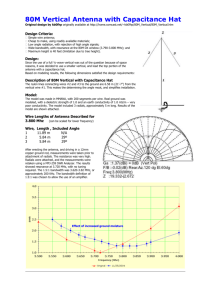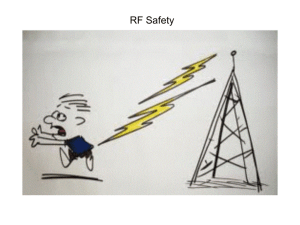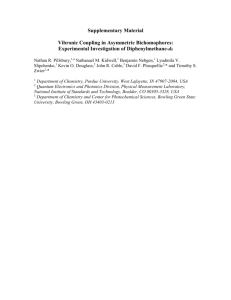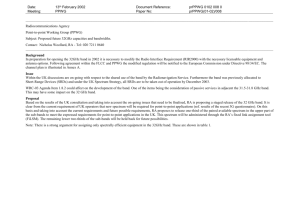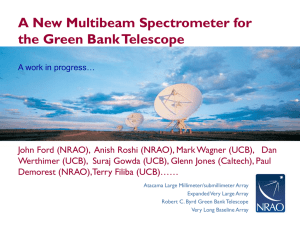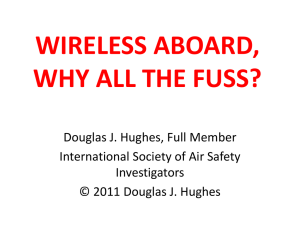AntennaTalk141116
advertisement
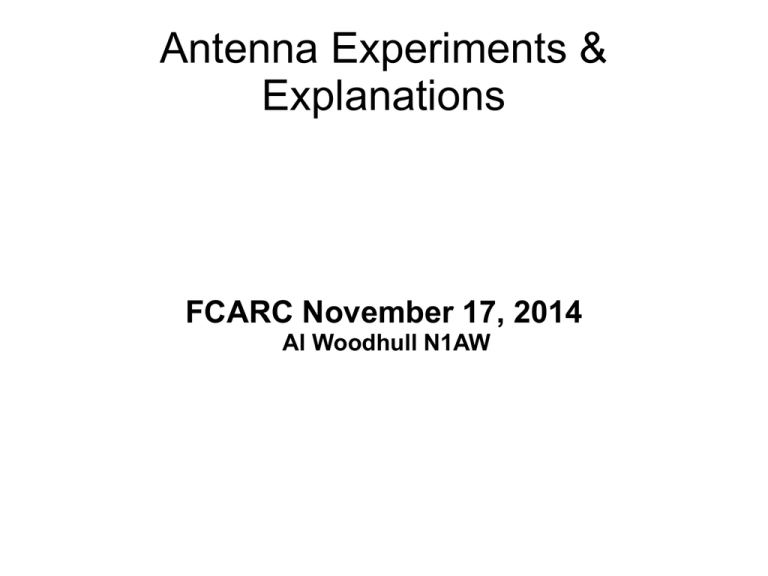
Antenna Experiments & Explanations FCARC November 17, 2014 Al Woodhull N1AW Hamstick antenna Hamstick dipole mount. Antenna in the living room.... 1st try, good SWR at 14.076 MHz Antenna in the living room.... rotated 90 degrees, not so good now, best SWR only 2.4 at 14.570 MHz Lower is better – now SWR 2.0 at 14.160. Moral: you would really prefer to have your antenna up in a tree. What can we expect – some websites DX Propagation: Maximum Usable Frequency predictions: http://www.spacew.com/www/realtime.php Let's look a bit closer at that... KC1KRS in ARRL SS SSB Nov 15-16 2014: 14 states on 10 meters Sometimes you don't want DX, you want to make a more local contact. Critical frequency is what you want to know about... http://www.spacew.com/www/fof2.html Let's look at these sites in real time Propagation forecasts are nice, but you can do more using Internet tools... RBN (Reverse Beacon Network) is a network of listening posts around the world that scan entire bands and decode and report digital (including CW) signals heard. http://www.reversebeacon.net/ (Sorry, it doesn't work for voice modes, yet) You can look for your own signal – the next slide is the result while testing indoor antennas at my house a few days ago. After that we'll try it live... with some variations. There is also a network of Software Defined Radios - the WebSDR. Here you can see a graphic display in real time of all the signals in a range of frequencies and you can select any one signal and hear how it sounds at the distant site. At http://www.websdr.org/ you can see all the sites available to choose from. My favorite is a site in New Jersey, I sometimes monitor our Snail Net by looking at this site: http://96.225.100.244:8902/ (Note he is using a dynamic DNS service – his address may change from time to time Before going on to part 2, try these things live on web: (see whether 20 meters still open, maybe go to 40) On RBN, Look for my own signal as dx Look for W1AW/1 or W1AW/5 as dx Look at K1TTT as de On WebSDR – see if we can be seen in NJ or somewhere else not too far If not us look for something else – W1AW/* good bet Part 2: Explanations... The magic of ¼ wavelength wires The J-pole – why so popular? J-pole antenna: a half-wave dipole and a tapped quarter wave stub. You can make it out of copper pipe: You can make it from twinlead How it works: the voltage on a half-wave dipole is maximum at the ends. The current is lowest where voltage is highest and vice-versa. A quarter wave matching section transforms the high impedance at the bottom of the half wave to very low at the shorted end. By connecting the feed line at a tap on the matching section about 1/10th of the way from the low impedance end a match to the relatively low feedline impedance is made. Al's twinlead J-Pole The Magic of the Quarter Wave A simple quarter wave vertical needs a ground connection. A quarter wavelength radial is a virtual ground – the high impedance at the open end makes the other end exactly equivalent to a connection to ground. The ground plane antenna would work OK with just one radial, but having more than one makes the directional pattern symmetrical. How Long is a ¼ wavelength? Quarter wave (ft) = 234 / freq (MHz) 3.5 MHz 67' 7.0 MHz 33' 10 MHz 23' 14 MHz 16' 18 MHz 13' 21 MHz 11' 25 MHz 9' 28 MHz 8' 50 MHz ~5' 146 MHz ~19” 440 MHz ~6.4” Multi-band radials – this is how Butternut suggests you can make a multi-band radial for the HF6V multiband vertical antenna. A partial explanation of how it works.... N1AW HF6V N1AW HF6V Elevated radials N1AW HF6V Elevate radials and feedpoint The End This Powerpoint file will be online at: http://www.fcarc.org/Files/AntennaTalk141116.ppt


